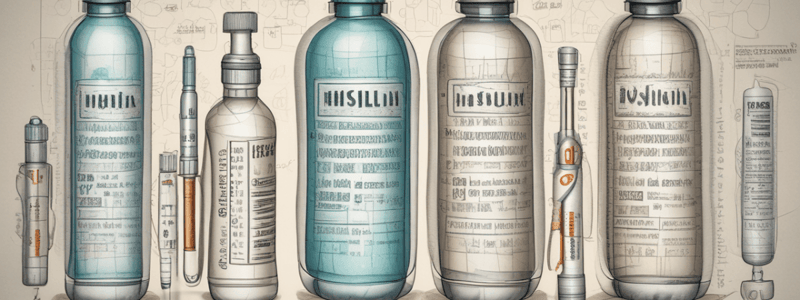Podcast
Questions and Answers
When should intermittent SC injections be administered in relation to starting a meal?
When should intermittent SC injections be administered in relation to starting a meal?
- Within 15 minutes before to 20 minutes after starting the meal (correct)
- After 1 hour of finishing the meal
- 30 minutes after finishing the meal
- At least 1 hour before the meal
What is the onset timing following an SC injection of Regular insulin?
What is the onset timing following an SC injection of Regular insulin?
- 4 hours
- 2 hours
- 30 minutes (correct)
- 5 minutes
What is the duration of action of Regular insulin?
What is the duration of action of Regular insulin?
- 5 to 7 hours (correct)
- 10 to 16 hours
- 1 to 3 hours
- 2 to 4 hours
Why is Neutral Protamine Hagedorn (NPH) insulin not suitable for IV use?
Why is Neutral Protamine Hagedorn (NPH) insulin not suitable for IV use?
In what clinical situation is Regular insulin typically used intravenously?
In what clinical situation is Regular insulin typically used intravenously?
What is the clinical use of Neutral Protamine Hagedorn (NPH) insulin?
What is the clinical use of Neutral Protamine Hagedorn (NPH) insulin?
What is metformin primarily known for in the treatment of diabetes?
What is metformin primarily known for in the treatment of diabetes?
How is metformin absorbed into hepatocytes when taken orally?
How is metformin absorbed into hepatocytes when taken orally?
Which is a common misconception about the efficacy of metformin compared to sulfonylureas?
Which is a common misconception about the efficacy of metformin compared to sulfonylureas?
Which mechanism of action is attributed to metformin's ability to lower hepatic glucose production?
Which mechanism of action is attributed to metformin's ability to lower hepatic glucose production?
What term describes metformin as an agent that works against high blood sugar levels?
What term describes metformin as an agent that works against high blood sugar levels?
What is the primary target organ of metformin's glucose-lowering effects?
What is the primary target organ of metformin's glucose-lowering effects?
What is the purpose of continuous subcutaneous insulin pumps?
What is the purpose of continuous subcutaneous insulin pumps?
What are the advantages of using portable pen-sized injectors for insulin administration?
What are the advantages of using portable pen-sized injectors for insulin administration?
What is a notable side effect associated with the rapid-acting inhaled formulation of insulin (Afrezza®)?
What is a notable side effect associated with the rapid-acting inhaled formulation of insulin (Afrezza®)?
What makes the standard therapy for insulin treatment different from intensive treatment?
What makes the standard therapy for insulin treatment different from intensive treatment?
Why is the inhaled formulation of insulin contraindicated in patients with lung disease?
Why is the inhaled formulation of insulin contraindicated in patients with lung disease?
How does the inhaled formulation of insulin (Afrezza®) benefit patients in terms of mealtime insulin coverage?
How does the inhaled formulation of insulin (Afrezza®) benefit patients in terms of mealtime insulin coverage?
What contributes to the lowering of glucose production when AMP levels are increased?
What contributes to the lowering of glucose production when AMP levels are increased?
How does increased AMPK activation affect mitochondrial glycerol-3-phosphate dehydrogenase (mGPD)?
How does increased AMPK activation affect mitochondrial glycerol-3-phosphate dehydrogenase (mGPD)?
Why can an accumulation of lactate to dangerous levels occur in some patients taking metformin?
Why can an accumulation of lactate to dangerous levels occur in some patients taking metformin?
How is metformin eliminated from the body?
How is metformin eliminated from the body?
In patients with kidney disease, what indication suggests the risk of lactic acidosis when taking metformin?
In patients with kidney disease, what indication suggests the risk of lactic acidosis when taking metformin?
What role does Adenosine Monophosphate-Activated Protein Kinase (AMPK) play in glucose production?
What role does Adenosine Monophosphate-Activated Protein Kinase (AMPK) play in glucose production?
What is the main outcome of thiazolidinediones (TZD)-mediated effects on gene expression?
What is the main outcome of thiazolidinediones (TZD)-mediated effects on gene expression?
What is the function of GLUT-4 transporter mentioned in the text?
What is the function of GLUT-4 transporter mentioned in the text?
Which compound is NOT listed as an enzyme whose expression is increased by thiazolidinediones (TZDs)?
Which compound is NOT listed as an enzyme whose expression is increased by thiazolidinediones (TZDs)?
What led to the removal of troglitazone (Rezulin®) from the market?
What led to the removal of troglitazone (Rezulin®) from the market?
What is the recommended frequency of liver function tests when treating a patient with TZD agents according to the text?
What is the recommended frequency of liver function tests when treating a patient with TZD agents according to the text?
What is emphasized regarding rosiglitazone (Avandia®) and pioglitazone (Actos®) in the text?
What is emphasized regarding rosiglitazone (Avandia®) and pioglitazone (Actos®) in the text?
Flashcards are hidden until you start studying
Study Notes
Insulin Administration and Pharmacokinetics
- Intermittent subcutaneous (SC) injections should be administered approximately 15-30 minutes before a meal.
- The onset of action for regular insulin following an SC injection is about 30 minutes.
- The duration of action for regular insulin lasts approximately 6 to 8 hours.
- Neutral Protamine Hagedorn (NPH) insulin is not suitable for intravenous (IV) use due to its prolonged duration and potential for unpredictable absorption.
- Regular insulin is typically used intravenously in critical situations like diabetic ketoacidosis or during surgeries when tight glycemic control is required.
Metformin and Its Mechanisms
- Metformin is primarily known for its ability to lower blood glucose levels in type 2 diabetes.
- It is absorbed into hepatocytes through facilitated diffusion, mainly using the organic cation transporters.
- A common misconception is that metformin is less effective than sulfonylureas in lowering blood sugar when, in fact, it has distinct advantages, including a lower risk of hypoglycemia.
- The mechanism by which metformin lowers hepatic glucose production is through the activation of AMP-activated protein kinase (AMPK).
- Metformin is classified as an antihyperglycemic agent; it works against elevated blood glucose levels.
- The primary target organ for metformin's glucose-lowering effects is the liver.
Insulin Delivery Systems
- Continuous subcutaneous insulin pumps aim to provide a steady delivery of insulin, improving overall glycemic control.
- Portable pen-sized injectors offer advantages in convenience, precision, and dosing flexibility for insulin administration.
- A notable side effect associated with the rapid-acting inhaled formulation of insulin (Afrezza®) is potential lung-related adverse effects, including cough and reduced lung function.
- Standard therapy for insulin treatment typically involves fewer injections and less intensive monitoring, contrasting with intensive treatment protocols requiring more frequent dosing and checks.
Considerations for Inhaled Insulin
- The inhaled formulation of insulin is contraindicated in patients with any lung disease due to risks of respiratory complications.
- Afrezza® provides rapid mealtime insulin coverage, mimicking physiological insulin release and effectively addressing postprandial glucose spikes.
- Increased AMP levels contribute to a reduction in glucose production, promoting better glycemic control when AMPK is activated.
Metformin Metabolism and Risks
- Metformin is eliminated primarily through the kidneys.
- In patients with kidney disease, a reduced glomerular filtration rate (GFR) suggests an increased risk of lactic acidosis, a potentially serious side effect of metformin.
Thiazolidinediones (TZDs) Impact
- Adenosine Monophosphate-Activated Protein Kinase (AMPK) plays a critical role in reducing hepatic glucose production through modulation of metabolic pathways.
- Thiazolidinediones (TZDs) mediate effects on gene expression, enhancing insulin sensitivity and improving lipid metabolism.
- The GLUT-4 transporter facilitates glucose uptake in muscle and fat tissues, playing a key role in overall glucose homeostasis.
- Enzymes not included as expressed by TZDs include those related to gluconeogenesis inhibition.
- Troglitazone (Rezulin®) was removed from the market due to severe liver toxicity and associated complications.
- Regular liver function tests are recommended every 3 to 6 months for patients treated with TZD agents to monitor for potential hepatotoxicity.
- Rosiglitazone (Avandia®) and pioglitazone (Actos®) have been emphasized for their efficacy in improving insulin sensitivity, with caution against cardiovascular risks associated with their use.
Studying That Suits You
Use AI to generate personalized quizzes and flashcards to suit your learning preferences.




